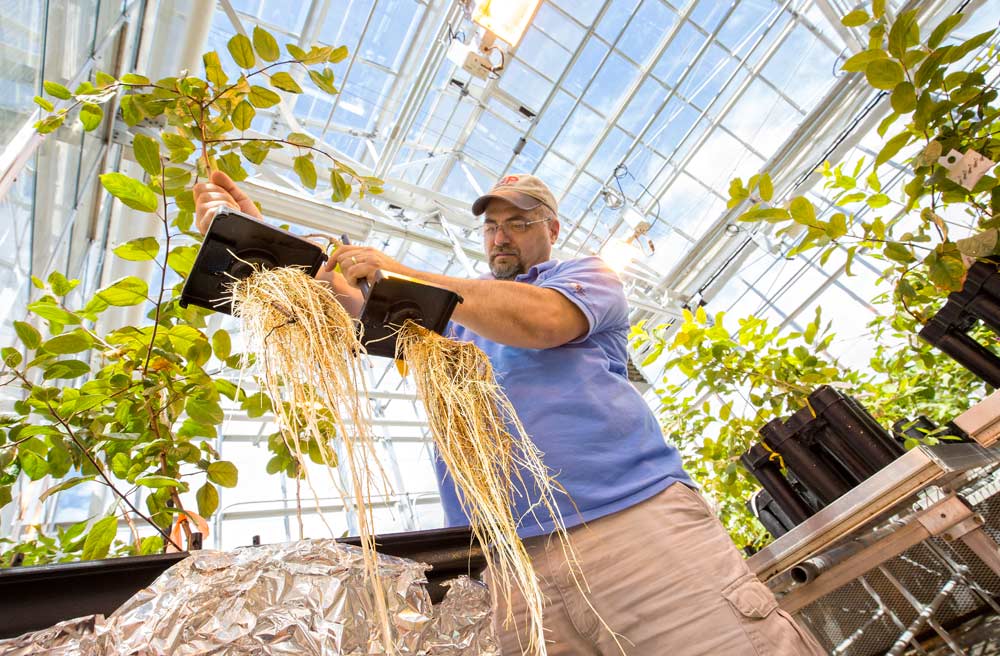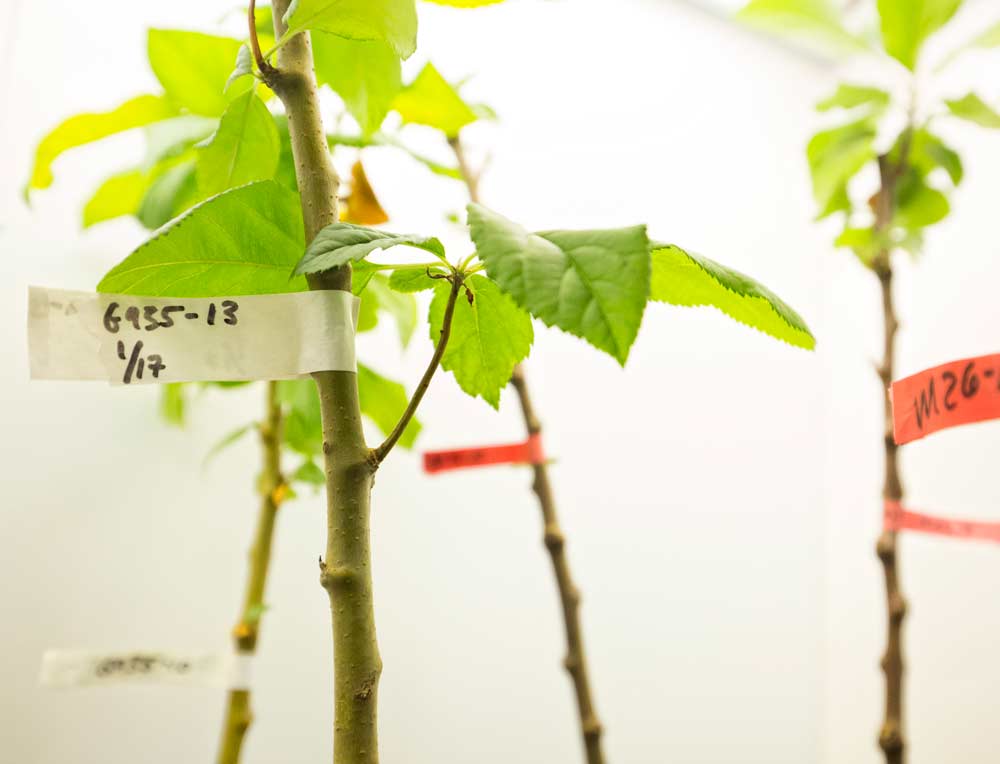
At right, Gennaro Fazio, a plant breeder and research geneticist with the U.S. Department of Agriculture’s Agricultural Research Service, shows the root growth on two Geneva 16 rootstocks at Cornell University’s Geneva, New York, greenhouses in July 2016. (TJ Mullinax/Good Fruit Grower)
To understand how rootstocks interact with soil that normally envelops them, it helps to grow them naked.
That irony isn’t lost on Gennaro Fazio, who has just finished setting up an aeroponic system to grow hundreds of naked apple rootstocks fed only by a nutrient rich mist at the U.S. Department of Agriculture’s research station in Geneva, New York.
“It’s a really neat system that can help us tackle many questions,” said Fazio, a geneticist who runs the Geneva rootstock breeding program.
Without soil and the bacteria, fungi, nematodes and other microbes that inhabit it, it’s easier to study exactly what roots are doing and what genes are turned on and guiding its growth.
For every naked rootstock in the aeroponic system, there’s a genetic match growing in soil in a separate experiment studying how different rootstocks interact with soil organisms.
Those relationships could explain why some rootstocks are more susceptible to soil-borne diseases and why others appear to provide the scion a nutritional boost.
It’s one piece of a new $4.3 million, five-year research effort to accelerate rootstock development for high-density apple orchards with a focus on resilience to soil stresses and replant disease, along with improved horticulture and nutrition.
The USDA-funded effort led by Cornell University Horticulturist Lailiang Cheng will involve 13 researchers leading lab and field trials in New York, Washington, Utah, Michigan and Idaho.
“What we’re trying to do is enhance productivity of the system,” said Mark Mazzola, a pathologist for the U.S. Department of Agriculture’s Tree Fruit Research Laboratory in Wenatchee, Washington.
His role in the project is looking at how rootstocks interact with soil organisms to determine how growers can take advantage of the biology residing in orchard soils to more efficiently use the fertility that’s added to the system or to reduce pathology.
Today, the susceptibility of high-yield commercial rootstocks to replant disease and soil stresses costs the U.S. apple industry about $300 million a year. Better rootstocks and deeper understanding of the benefits offered by different rootstocks could reduce losses by 15 percent, according to the grant proposal.
“The grant is designed to delve deep into how apple rootstocks do what they do. What’s exciting for me is that it’ll help me with breeding, and when we are finished, it will help the grower understand how they can leverage rootstocks in their own field,” Fazio said. “For example, one of the traits we are looking for is calcium uptake and translocation into the scion. It’s such an important mineral for postharvest diseases and disorders.”
The root of the research
About a decade ago, growers began noticing that Honeycrisp planted on Budagovsky 9 rootstock produced apples with less bitter pit, said Dale Goldy, horticulturalist for Stemilt Ag Services.
That observation led to discussion by scientists at an NC 140 Regional Rootstock Research Project meeting about how B.9 might be carrying more calcium from the soil to the tree — and what other rootstock benefits might go unnoticed.
So a team of scientists and industry stakeholders got together to develop a plan to improve rootstock research and breeding nicknamed “Root2Fruit,” said Goldy, who serves on the effort’s stakeholder committee.
The goal is to uncover genetic advantages hiding in some rootstocks’ DNA that have long gone unnoticed in breeding programs focused on yield and size. An apple-focused version of the proposal finally received funding in 2016 and research is starting this year.
“We don’t know exactly what we’re going to learn just yet, but the hope is that we are going to target rootstocks that have horticultural and nutritional benefits,” Goldy said. He added that Stemilt Growers of Wenatchee, Washington, will plant a trial orchard this spring as part of the effort.

Geneva 935 and Malling 26 rootstocks at the USDA-ARS laboratory grow chamber in Wenatchee. “Malling 26 is susceptible to many of the pathogens that incite replant disease, whereas G.935 is somewhat tolerant to the disease,” Mazzola said. His research team is looking for metabolites that either attract certain pathogens or recruit beneficial organisms to help suppress the tree’s sensitivity to these various pathogens. (TJ Mullinax/Good Fruit Grower)
The scope of the five-year grant includes:
—Tapping existing field trials and planting new ones to examine which rootstocks provide the best nutrient uptake, which protect against disorders, and which can tolerate higher salinity and soil alkalinity.
—Studying the economic benefits offered by rootstock options and the economic barriers to adoption of new rootstocks.
—Using genetic analysis to identify beneficial traits and develop DNA marker tests to guide breeding efforts.
—Studying how replant disease-susceptible and tolerant rootstocks each interact with the soil microbe community.
An immune system in the soil?
Studying the microbe community that surrounds orchard roots might seem like a separate issue from breeding disease-resistant rootstocks, but in fact the issues may be intrinsically linked.
Root zone — or rhizosphere — organisms include many pathogens, but scientists are learning that other organisms protect against those pathogens, like a silent, soil immune system for the plants. They prey on pathogens, produce antibiotics, or just out-compete unwanted organisms.
Take replant disease. The cause of replant disease — a complex of fungi and lesion nematodes — is well established, but less well understood is how other organisms fight off the pathogens.
Encouraging these beneficial microbes with mustard seed meal, mulches and certain cover crops has been shown to offer longer-lasting replant disease control than fumigation.
But Mazzola believes that some rootstocks also work to cultivate these beneficial microbes themselves. Plant roots do this by exuding specific chemicals, such as sugars or acids.

Mark Mazzola opens a small laboratory door showing several apple tree rootstocks being tested at the USDA-ARS physiology and pathology of tree fruits research unit in Wenatchee, Washington, this year. The chamber helps researchers find differences in the metabolic composition of root exudates of different rootstocks. (TJ Mullinax/Good Fruit Grower)
“Plants have the capacity to use these rhizosphere organisms as a first line of defense. So the question is, which rootstocks have a better capacity to attract these beneficial communities? And the next question is, how do they do that?” Mazzola said. “If we can link (that ability) to DNA markers, that would be a significant advancement to the breeding program.”
In a related project funded by the Washington Tree Fruit Research Commission, Mazzola’s team has found that Geneva 41, G.935, and Malling 9 rootstocks acquire distinctly different microbe communities. The research is still underway, but the differences might be why Geneva rootstocks have greater resilience to replant disease.
The key to translating these findings into orchards is understanding why certain rootstocks can recruit beneficial communities and why others are more susceptible to pathogens such as lesion nematodes or the fire-blight causing bacteria, Erwinia amylovora.
Piecing that puzzle together involves identifying key microbes, determining what the roots exude to entice or deter the microbes, and then figuring out what genes cause the plant to produce those compounds.
That’s a tall order, but it’s exactly what the paired experiments in Fazio and Mazzola’s labs aim to do.
High-powered DNA sequencing now allows scientists to catalog all microbes present in a soil sample — rather than just screening for known pathogens — and compare communities.
Now, to understand how rootstocks influence those communities, Mazzola’s lab is collecting the different chemicals that the roots exude into the soil and analyzing them to discover composition and function.
Meanwhile, Fazio’s breeding program will analyze the DNA of hundreds of rootstock genotypes that he is growing in the isolated aeroponic system.
By reading just the DNA that’s being translated into proteins, Fazio can figure out which relevant genes are turned on. And each genotype — genetically distinct rootstock — is matched with rootstocks in Mazzola’s tests so they will ideally be able to connect the dots between genes and how the plants recruit soil communities.
This emerging field of science is exciting, but it is a long way from orchard results, Fazio and Mazzola cautioned. First, because soil ecosystems are incredibly complex and varied, and second, because it takes a long time to grow apple trees to ground-truth lab results.
“This stuff is years from being in the field and then more years to get answers because we are working in a perennial system,” Mazzola said. “Growers want to know, rightfully, does this increase yield? But they have to appreciate that it takes time to grow the trees to prove that.” •
– by Kate Prengaman






Leave A Comment